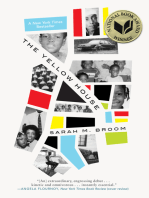0 ratings0% found this document useful (0 votes)
31 viewsNCM 117 Stress Anxiety
NCM 117 Stress Anxiety
Uploaded by
GABRIELLE JEANZ AZUMBRADO ACABOThis document discusses stress, anxiety, defense mechanisms, and crisis intervention. Some key points:
1. Stress can be caused by both positive and negative experiences and events. Prolonged negative stress can harm productivity, health, and lead to exhaustion if not managed properly.
2. The body has natural responses to stress like anxiety, and defense mechanisms to unconsciously protect from anxiety.
3. There are various coping strategies like problem-solving and emotion-focused coping to help manage stress responses. Sources of stress can be internal or external.
4. Prolonged or chronic stress can eventually exhaust physical, emotional, and mental resources if not addressed, as described in the General Adaptation Syndrome
Copyright:
© All Rights Reserved
Available Formats
Download as PDF, TXT or read online from Scribd
NCM 117 Stress Anxiety
NCM 117 Stress Anxiety
Uploaded by
GABRIELLE JEANZ AZUMBRADO ACABO0 ratings0% found this document useful (0 votes)
31 views7 pagesThis document discusses stress, anxiety, defense mechanisms, and crisis intervention. Some key points:
1. Stress can be caused by both positive and negative experiences and events. Prolonged negative stress can harm productivity, health, and lead to exhaustion if not managed properly.
2. The body has natural responses to stress like anxiety, and defense mechanisms to unconsciously protect from anxiety.
3. There are various coping strategies like problem-solving and emotion-focused coping to help manage stress responses. Sources of stress can be internal or external.
4. Prolonged or chronic stress can eventually exhaust physical, emotional, and mental resources if not addressed, as described in the General Adaptation Syndrome
Copyright
© © All Rights Reserved
Available Formats
PDF, TXT or read online from Scribd
Share this document
Did you find this document useful?
Is this content inappropriate?
This document discusses stress, anxiety, defense mechanisms, and crisis intervention. Some key points:
1. Stress can be caused by both positive and negative experiences and events. Prolonged negative stress can harm productivity, health, and lead to exhaustion if not managed properly.
2. The body has natural responses to stress like anxiety, and defense mechanisms to unconsciously protect from anxiety.
3. There are various coping strategies like problem-solving and emotion-focused coping to help manage stress responses. Sources of stress can be internal or external.
4. Prolonged or chronic stress can eventually exhaust physical, emotional, and mental resources if not addressed, as described in the General Adaptation Syndrome
Copyright:
© All Rights Reserved
Available Formats
Download as PDF, TXT or read online from Scribd
Download as pdf or txt
0 ratings0% found this document useful (0 votes)
31 views7 pagesNCM 117 Stress Anxiety
NCM 117 Stress Anxiety
Uploaded by
GABRIELLE JEANZ AZUMBRADO ACABOThis document discusses stress, anxiety, defense mechanisms, and crisis intervention. Some key points:
1. Stress can be caused by both positive and negative experiences and events. Prolonged negative stress can harm productivity, health, and lead to exhaustion if not managed properly.
2. The body has natural responses to stress like anxiety, and defense mechanisms to unconsciously protect from anxiety.
3. There are various coping strategies like problem-solving and emotion-focused coping to help manage stress responses. Sources of stress can be internal or external.
4. Prolonged or chronic stress can eventually exhaust physical, emotional, and mental resources if not addressed, as described in the General Adaptation Syndrome
Copyright:
© All Rights Reserved
Available Formats
Download as PDF, TXT or read online from Scribd
Download as pdf or txt
You are on page 1of 7
NCM 117 PRINCIPLES OF STRESS
Anxiety, Stress, Defense mechanism and § Universal phenomenon
Crisis Intervention - Stress can affect and can be
experienced by everyone and living
Topics beings
§ Stress § It can be a result from both positive
- A feeling of emotional and physical and negative experiences.
crisis and tension - Stress can be positive or negative
depending on the situation. If
§ Anxiety continuous, negative stress can
- A part of body’s natural response to lead to loss of productivity, health
stress, a feeling of fear and problems and even exhaustion.
apprehension § Stressor is any factor that produce
stress & disrupt body’s equilibrium.
§ Defense Mechanisms - It is anything that may cause the
- Set of psychological strategies that release of the stress hormones
are unconsciously used to protect a commonly known as your ‘cortisol’.
person from anxiety arising from
unacceptable thoughts or feelings RESPONSES TO STRESS
§ Coping Strategies
§ Grief § Coping Responses
- Commonly a response to loss § Coping Mechanisms
particularly to the loss of someone These responses referred to the specific
or something significant efforts both behavioral and psychological that
people employ to master, tolerate, reduce or
§ Crisis even minimize stressful events.
- Generally, it is a time of intense
difficulty, trouble or danger that Two general coping strategies:
needs immediate intervention and 1. Problem solving strategies
prevention - the efforts to do something active to
elevate the stressful circumstances
§ Conflict
- A serious difference or argument of 2. Emotion focus coping strategies
a certain matter that may arise - it involves efforts to regulate the
attention emotional consequences of
stressful or potentially stressful
§ Frustration events
- Refers to the emotion of being
dismayed or infuriated because of SOURCES OF STRESS
the inability to change or achieve § Internal or External
something § Developmental or situational stressors
STRESS Internal Stress
§ It is a stimulus that arouse physiologic, § Originate within person
psychological reactions that may - Depression
increase the individual’s vulnerability to - Debilitating disease
illness.
§ REMEMBER: Stress is everywhere External Stress
§ Stress is a body’s reaction to harmful § Originates outside the individual
situations whether they are real or - Death in family
perceived - Peer pressures
§ Hans Selye - Having to move to another city
- Father of stress research
- “nonspecific response of the body to
any kind of demand made upon it”
However not all forms or levels of stress are Personality of the child as well as the available
bad, for example: competing in sport and support from the family members plays a great
achieving school or at work are examples of role in the child's ability to handle stressful
positive stressors. situations.
EFFECTS OF STRESS § ADOLESCENT
§ Physical: Threaten homeostasis. - Choosing career
- This is very common to endocrine o it must be in line with their
hormone interactions. Ideally, these capacities and function
endocrine hormones will ensure the - Independence
body's internal environment remains o this is expected as the young
stable, however stress can disrupt individual becomes mature and
this stability. more responsible
- Developing relationships
§ Emotional: Negative feelings about self. o commonly when it comes to
- These unpleasant emotions truly sexual attraction
reduce the human’s confidence,
self-esteem and general life RESPONSE-BASED MODELS
satisfaction. Poorly managed We can’t remove every single stressor from
negative emotions are not good for our life but it's possible to manage stress and
your health. maintain your health.
§ Social: Alter relationships w/ others. By HANS SELYE
- Stress greatly affects the human § General Adaptation Syndrome
personal lives affecting the quality of - Stress is a state of the body and can
human relationship. When people be observed only by changes it
are stressed, they become more produces in the body.
withdrawn and distracted unless - This syndrome describes the
affectionate to others. physiological changes the body
goes through when under stress
§ Spiritual: challenge one’s beliefs &
values.
- Coping with stress is the process by
which a person consciously
attempts to master, minimize or
tolerate stressors and problems in
life. When the person is seriously
stressed, tendencies are it really
affects the person's ability, believes,
values and perception. It truly
challenges the persons trust
towards his or her is spirituality.
GAS 3 STAGES:
STRESSORS ASSOCIATED WITH 1. Alarm reaction stage
DEVELOPMENTAL STAGES - refers to the initial symptoms that
§ CHILD: How your child reacts to stress the body experiences when under
depends upon both your child and the stress
source of stress)
- Beginning school 2. Resistance stage
- Coping with peer competition - After the initial shock of a stressful
- Resolving conflict between event and having a fight or flight
independence and dependence response, the body begins to repair
itself.
3. Exhaustion stage progress if you think of specific and
- This stage is the result of prolonged realistic ways that you can solve
or chronic stress. Struggling with your problem
stress for long periods could drain
your physical, emotional and mental F. Pets
resources to the point where your - As part of recreational activities,
body no longer had strength to fight having pets or animals can reduce
stress loneliness, increase the feelings of
social support and boost your mood.
PSYCHOLOGICAL INDICATORS OF It will also divert your attention and
STRESS energy into a fun activity
ü Anxiety experience.
ü Fear
ü Anger G. Music
ü Depression - Different tones, tempo and rhythm
ü Unconscious ego defense can change the person's mood. It
mechanisms will relax the person's muscles, feel
happy, sooth and can lower the
MANAGEMENT OF STRESS stress response.
A. Awareness
- The first way to handle stress is to ANXIETY
become aware of it, acknowledge it § A vague sense of impending doom, an
and accept its presence. Realize apprehension or a sense of dread as a
that the thoughts you are thinking result of anticipated danger or threat to
are literally coined from the one’s identity or self-esteem wherein
environment and experiences. the source is unknown.
§ “Fear of the unknown.”
B. Relaxation Even if anxiety is a normal and often healthy
- Relaxation techniques can help the emotion. However, when a person regularly
human body relax and lower your feels disproportionate levels of anxiety, it might
blood pressure, heart rate and other become a medical disorder.
vital science components.
FEAR
C. Meditation § feeling afraid or threatened by a clearly
- Meditation can produce a deep identifiable external stimulus that
state of relaxation and serene mind. represents danger to the person.
This kind of activity may result and
enhance physical and emotional LEVELS OF ANXIETY
well-being 1. MILD
- Perceptual field is broad and
D. Interpersonal Communication organized.
- This states that simply talking about - Client is able to focus realistically on
our problems and sharing our most of what is happening.
negative emotions with someone ü senses are alert
with trust can be profoundly healing ü ↑ attention
because it may reduce stress and ü ↑motivation for learning, ↑problem
will strengthen our immune system solving skills, ↑thought process,
and reduce the physical and ↑creativity
emotional distress. ü perceptual field is broad and organized
ü “Motivating Force”
E. Problem solving Actually, mild anxiety serves a very functional
- Problem solving helps the person purpose when at a healthy level and It has full
overcome complex stressful events. of advantages and benefits. Some of it could
After solving, the problem is lifted be helpful in making decision, increase in
then. It will be easier to make focus and concentration.
2. MODERATE USES OF DEFENSE MECHANISMS
- Have more frequent or persistent 1. To resolve a mental conflict
symptoms than those with mild 2. To reduce anxiety or fear
anxiety. 3. To protect one’s self-esteem
- Have better daily functioning than 4. To protect one’s sense of security
someone with a severe anxiety or
panic disorder. MAJOR DEFENSE MECHANISM
ü Narrowed perception 1. COMPENSATION
ü Selective inattention - It is the covering up of real or
ü Detected through complaining and perceived weakness by
arguing behavior emphasizing a trait one considers
more desirable.
3. SEVERE - It serves as substitution or
- Frequently have intense, excessive development of strength or
and persistent worry and fear about capability in one area to offset real
every situation. or imagined efficiency in another.
ü Greatly decreased perceptual field
ü Focus is on specific details 2. DENIAL
ü All behavior is armed at getting relief - It is the refusal to acknowledge the
now. Need immediate intervention existence of a real situation or
feelings associated with it.
HOW CAN NURSES MINIMIZE ANXIETY? - It is an emotional conflict and
§ Explain procedures before they are reduction of anxiety by refusing to
implemented. perceive or consciously
§ Have client verbalize feelings, acknowledge the more unpleasant
perceptions, & fears as appropriate. aspects of external reality.
§ Listen to the client.
§ Identify personal strengths. 3. DISPLACEMENT
§ Identify available support systems. - It is the transferring of feelings from
§ Have client participate in his/her plan of one target to another that is
care. considered less threatening.
- For example, eating to avoid
CONFLICT awareness of difficult personal
§ It is a result of the presence of two relations or aggressiveness toward
opposing or incompatible drives one person replacing original
wherein the person is required to make aggressiveness toward the other
a choice between possible responses.
§ Conflict is serious disagreement and 4. IDENTIFICATION
argument about something important. If - It is an attempt to increase self-
two people or groups are in conflict, worth by acquiring certain attributes
they have had a serious disagreement and a character of an individual one
or argument and have not yet reached admires.
any agreement. - Its more on emulating and following.
- Moreover, it is by means of a series
DEFENSE MECHANISMS of identifications that the personality
§ These are UNCONSCIOUS is constituted and specified.
MEASURES that people use to
DEFEND their personal stability and 5. INTELLECTUALIZATION
protect against anxiety and threat - It is an attempt to avoid expressing
resulting from conflicts among id, ego actual emotions associated with a
and superego. stressful situation by using
§ Are thought to safeguard the mind intellectual process of logic,
against feelings and thoughts that are reasoning and analysis.
too difficult for the conscious mind to - It’s a one way of defending your ego
cope with. and self-worth.
6. INTROJECTION 11. REGRESSION
- It is the internalization of beliefs and - It is the returning to less mature
values of another individual, so they patterns of behavior which provide
symbolically become a part of self to comfort.
the extent that the feeling of - Example: a child may begin to suck
separateness or distinctiveness is their thumb again or wet the bed
lost. when they need to spend some time
- Example: A dad telling his own son in the hospital.
“boys don't cry”. This is an idea that
a person might take it from their 12. REPRESSION
environment and internalize into - It is the involuntary blocking of
their way of thinking. unpleasant feelings and
experiences from one’s awareness.
7. ISOLATION - Is usually done to keep disturbing
- It is the separation of a thought or thoughts from becoming conscious.
memory from feelings, tone or During the audible complex,
emotions associated with it. aggressive thoughts about the
- It gives more time for the individual same sex are repressed and this is
to internalize in protecting his or involuntarily.
herself.
13. SUBLIMATION
8. PROJECTION - It is the channeling of intolerable
- It is when the individual accuses urges thoughts and feeling into
someone else of nasty or socially acceptable actions.
objectionable behavior and feelings - It is the diversion or deflection of
which actually are his own. instinctual drives usually the sexual
- It's keeping the discomfort about ones into non instinctual channels.
ourselves at day/bay (??) and
outside our awareness. 14. SUPRESSION
- It is the voluntary blocking of
9. RATIONALIZATION unpleasant feelings and
- This is the attempt to make excuses experiences from one’s awareness.
or formulate logical reasons to - This time, it's voluntary.
justify unacceptable feeling or
behavior. 15. UNDOING
- Major difference between - It is the engaging of an activity which
rationalization & intellectualization: is believed to negate the potential
o Both: protect the individual from for an unpleasant occurrence.
unpleasant or unacceptable - It is accomplished by doing things
aspects of reality that have the opposite meaning of
o Intellectualization does not the distressing impulses that they
distort facts through or individual wants to be
reinterpretation of situation or psychologically defended against.
motives whereas
rationalization does. GRIEF
§ Subjective state of emotional, physical
10. REACTION FORMATION & social responses to the loss of a
- It is the hiding of the true feelings by valued entity.
acting the opposite thereby § It is the loss may be real or it may be
protecting the ego from owning bad perceived by the individual alone.
thoughts. § It is the loss or anticipated loss of
- The feeling is not congruent to his or anything of value to an individual can
her expression. trigger the grief response.
GRIEVING 5. ACCEPTANCE
§ It is the process by which the grief is - It occurs when the person shows
experienced. evidence of coming to terms with
§ It involves not only the content [what a death/loss.
person thinks and feels] but also the Remain close to the patient and let him or her
process [how a person think, says and share his or her plans.
feels]
COPING REACTION TO DEATH
MOURNING THROUGHOUT THE LIFE CYCLE
§ It is the outward sign of grief, a way of 1. TODDLER (1-3 yrs. old)
integrating loss & grief into the life of the - No specific concept of death
bereaved. - Reacts more to pain and discomfort
of illness and immobilization.
STAGES OF GRIEVING [Kubler-Ross’s] - Separation anxiety a great deal.
1. DENIAL - Focus on Parents: assist parents to
- Shock & disbelief deal with their feelings. Parents
- Loss is unreal must encourage them to participate
In this stage breathing people are unable or in different forms of care.
unwilling to accept that the loss has taken
place. They perceive that the losses reveal 2. PRESCHOOLER (3-5 yrs. old)
and expecting that things will be normal. - Death is kind of SLEEP; a form of
punishment.
2. ANGER - Life and death can change place
- Anger towards God, relatives or friends with one another.
- Feeling of Abandonment - If a pet dies, they may request
funeral and burial.
Dealing with Client’s Anger - Nursing Interventions:
• Know your own response to anger. o Utilize play for expressing
• Accept client’s right to be angry. thoughts and feelings.
• Ask what caused the anger. o Explain what is death that it is
• Do not assume responsibility for client’s final and not sleep.
anger. o Permit a choice of attending a
• Let client talk about their anger. funeral.
• Listen to client & act as calmly as
possible. 3. SCHOOL AGE (5-12 yrs. old)
• Process your feelings & responses with - Death is personified
colleagues. - Child fears mutilation and
• Always be aware of safety for you, the punishment.
client and others - Anxiety is alleviated by nightmares
- Death is perceived as a final
3. BARGAINING process.
- It occurs when persons attempt to - As a nurse, accept regressive or
prolong the inevitable loss. protest behavior, its normal and
It is usually upon request if possible. The nurse expected. Let the client encourage
must practice active listening this time. the verbalization of their feelings.
4. DEPRESSION 4. ADOLESCENT (12-16 yrs. old)
- It occurs when the awareness - Mature understanding of death.
becomes acute. - May have strong emotions about
In this time of crisis avoid giving false death
reassurances as to the client just being with - Worry about their physical changes.
the client offer yourself. - Approaches:
o Support maturational crises.
o Encourage verbalization of
feeling
o Respect need for privacy and 3. Combination of developmental &
personal expression for anger, accidental crisis
sadness or fear. - Example: Pregnancy in women who
are victims of rape.
5. ADULT
- Death is a disruption of a lifestyle PERIODS OF CRISIS
- Death is viewed in terms of its effect § INITIAL: Rise in tension in response to
on significant others the initial impact of stress
6. OLDER ADULT § INTERMEDIATE: Emergency problem-
- Emphasis is on religious beliefs for solving mechanisms are called forth
comfort. which may lead to an actual solution of
- A time of reflection, rest, and peace the problem.
CRISIS THEORY & INTERVENTION § THIRD PHASE: Major disorganization
Crisis occurs if no solution occurs
§ It is a state of the reacting individual
who finds himself in a hazardous NURSING CARE:
situation in which the habitual problem- Help client to:
solving activities are not adequate and 1. Confront the crisis by verbalizing and
do not lead to the previously achieved comprehending reality of the situation.
balance state (Kaplan) 2. Confront the crisis in doses which he
can manage, being cautious not to
Crisis Intervention overly dampen the impact.
§ It means the entering into the life 3. Find facts rather than speculate about
situation of an individual, family to the situation.
alleviate the impact of a crisis including 4. By not giving false reassurance.
stress in order to help mobilize the Acknowledge the validity of fears and
resources of those directly affected as gives reassurance that there is faith in
well as those who are in significant his ability to manage.
social orbit. 5. Do not encourage him to blame others,
since blaming is a way of avoiding the
Crisis is an upset in a steady state truth (projection)
- in a hazardous situation. 6. Accept assistance with his everyday
- faces problems that he cannot readily tasks since crisis disorganizes and
solve by using the coping mechanisms disorients energies due to the
that have worked for him before. excessive amount of energy directed to
- As a result, his tension and anxiety the task of resolving the problem.
increases 7. By letting him solve his problem.
- less able to find a solution.
- He feels helpless and caught in a state The nurse will be the one to assist and to
of great emotional upset and feels guide or to facilitate in terms of managing or
unable to take action on his own to implementing any solutions or interventions.
solve his problem
THREE (3) TYPES OF CRISIS
1. Normal developmental or maturation
life crisis.
- Example: Birth, school-age,
marriage, pregnancy etc.
2. Abnormal and accidental or situational
life crisis.
- Example: Accident, death, illness,
etc.
You might also like
- The Subtle Art of Not Giving a F*ck: A Counterintuitive Approach to Living a Good LifeFrom EverandThe Subtle Art of Not Giving a F*ck: A Counterintuitive Approach to Living a Good LifeRating: 4 out of 5 stars4/5 (6022)
- The Gifts of Imperfection: Let Go of Who You Think You're Supposed to Be and Embrace Who You AreFrom EverandThe Gifts of Imperfection: Let Go of Who You Think You're Supposed to Be and Embrace Who You AreRating: 4 out of 5 stars4/5 (1132)
- Never Split the Difference: Negotiating As If Your Life Depended On ItFrom EverandNever Split the Difference: Negotiating As If Your Life Depended On ItRating: 4.5 out of 5 stars4.5/5 (909)
- Grit: The Power of Passion and PerseveranceFrom EverandGrit: The Power of Passion and PerseveranceRating: 4 out of 5 stars4/5 (628)
- Hidden Figures: The American Dream and the Untold Story of the Black Women Mathematicians Who Helped Win the Space RaceFrom EverandHidden Figures: The American Dream and the Untold Story of the Black Women Mathematicians Who Helped Win the Space RaceRating: 4 out of 5 stars4/5 (937)
- Shoe Dog: A Memoir by the Creator of NikeFrom EverandShoe Dog: A Memoir by the Creator of NikeRating: 4.5 out of 5 stars4.5/5 (547)
- The Hard Thing About Hard Things: Building a Business When There Are No Easy AnswersFrom EverandThe Hard Thing About Hard Things: Building a Business When There Are No Easy AnswersRating: 4.5 out of 5 stars4.5/5 (358)
- Her Body and Other Parties: StoriesFrom EverandHer Body and Other Parties: StoriesRating: 4 out of 5 stars4/5 (831)
- Elon Musk: Tesla, SpaceX, and the Quest for a Fantastic FutureFrom EverandElon Musk: Tesla, SpaceX, and the Quest for a Fantastic FutureRating: 4.5 out of 5 stars4.5/5 (480)
- The Emperor of All Maladies: A Biography of CancerFrom EverandThe Emperor of All Maladies: A Biography of CancerRating: 4.5 out of 5 stars4.5/5 (275)
- The Little Book of Hygge: Danish Secrets to Happy LivingFrom EverandThe Little Book of Hygge: Danish Secrets to Happy LivingRating: 3.5 out of 5 stars3.5/5 (434)
- The Yellow House: A Memoir (2019 National Book Award Winner)From EverandThe Yellow House: A Memoir (2019 National Book Award Winner)Rating: 4 out of 5 stars4/5 (99)
- The World Is Flat 3.0: A Brief History of the Twenty-first CenturyFrom EverandThe World Is Flat 3.0: A Brief History of the Twenty-first CenturyRating: 3.5 out of 5 stars3.5/5 (2281)
- Devil in the Grove: Thurgood Marshall, the Groveland Boys, and the Dawn of a New AmericaFrom EverandDevil in the Grove: Thurgood Marshall, the Groveland Boys, and the Dawn of a New AmericaRating: 4.5 out of 5 stars4.5/5 (273)
- The Sympathizer: A Novel (Pulitzer Prize for Fiction)From EverandThe Sympathizer: A Novel (Pulitzer Prize for Fiction)Rating: 4.5 out of 5 stars4.5/5 (125)
- PDF Texto 6 Dysphoria Mundi Preciado CompressDocument40 pagesPDF Texto 6 Dysphoria Mundi Preciado CompressFernando Lapuente-GarcíaNo ratings yet
- A Heartbreaking Work Of Staggering Genius: A Memoir Based on a True StoryFrom EverandA Heartbreaking Work Of Staggering Genius: A Memoir Based on a True StoryRating: 3.5 out of 5 stars3.5/5 (233)
- Team of Rivals: The Political Genius of Abraham LincolnFrom EverandTeam of Rivals: The Political Genius of Abraham LincolnRating: 4.5 out of 5 stars4.5/5 (235)
- On Fire: The (Burning) Case for a Green New DealFrom EverandOn Fire: The (Burning) Case for a Green New DealRating: 4 out of 5 stars4/5 (75)
- The Unwinding: An Inner History of the New AmericaFrom EverandThe Unwinding: An Inner History of the New AmericaRating: 4 out of 5 stars4/5 (45)
- D5IMBDocument1 pageD5IMBPrincess Garrote50% (2)
- Manual G2 en PDFDocument73 pagesManual G2 en PDFshakibur rahman100% (1)
- Bani East Integrated School Bani: Department of Education Schools Division Office I Pangasinan LingayenDocument2 pagesBani East Integrated School Bani: Department of Education Schools Division Office I Pangasinan LingayenJoel Phillip GranadaNo ratings yet
- Lesson Plan First AidDocument13 pagesLesson Plan First AidAlfie AyroNo ratings yet
- CBC HilotDocument16 pagesCBC HilotMARK EMIL JHAMAICA TOLENTINO SAGUNNo ratings yet
- Incicedent and Reporting ProcedureDocument12 pagesIncicedent and Reporting ProcedureVALENTINE T NHOPINo ratings yet
- Health Professionals in Support of Paid Family LeaveDocument3 pagesHealth Professionals in Support of Paid Family LeaveCommunity Service Society of New YorkNo ratings yet
- Muhammad Rehan Khan Maintenance EngineerDocument13 pagesMuhammad Rehan Khan Maintenance EngineerHamza NoumanNo ratings yet
- Can Extreme Sports Treat Anxiety - Sierra ClubDocument1 pageCan Extreme Sports Treat Anxiety - Sierra ClubRodrigo LeçaNo ratings yet
- PasTest MCQs With AnswersDocument562 pagesPasTest MCQs With Answersياسر بن خميسNo ratings yet
- FORMAT LAPORAN GBLT1 NEW Per TGL 20 OKT 2018Document735 pagesFORMAT LAPORAN GBLT1 NEW Per TGL 20 OKT 2018Diny Rachma Putri HNo ratings yet
- Enxe Program Scientific 2023Document55 pagesEnxe Program Scientific 2023Thanos MastrokostasNo ratings yet
- SiDa Schmierfett01 KHS Multi Grease 01 ENDocument10 pagesSiDa Schmierfett01 KHS Multi Grease 01 ENHareem FatimaNo ratings yet
- B. Inggris 2: Establishing A Relationship (Greeting & Introducing)Document9 pagesB. Inggris 2: Establishing A Relationship (Greeting & Introducing)DefaNo ratings yet
- Oxford English For Careers - Medicine1 .Unit 2Document5 pagesOxford English For Careers - Medicine1 .Unit 2Linda JamburiaNo ratings yet
- Technology and Livelihood Education Quarter 2: Raising Dairy Animals (RDA)Document26 pagesTechnology and Livelihood Education Quarter 2: Raising Dairy Animals (RDA)Ssa RiNo ratings yet
- Addis Ababa University: Course: Environmental PlanningDocument80 pagesAddis Ababa University: Course: Environmental PlanningHabtie Habtie ZewduNo ratings yet
- ElsaesserDocument12 pagesElsaesserapi-512197340No ratings yet
- Unit 4 ReadingDocument4 pagesUnit 4 ReadingElvantNo ratings yet
- Unit 13_CRP_Report_ 2021_2022 -Digital TransformationDocument122 pagesUnit 13_CRP_Report_ 2021_2022 -Digital Transformationfixittechnical.infoNo ratings yet
- Anesthesia for Congenital Heart Disease 4th Edition Dean B Andropoulos Emad B Mossad Erin A Gottlieb download pdfDocument45 pagesAnesthesia for Congenital Heart Disease 4th Edition Dean B Andropoulos Emad B Mossad Erin A Gottlieb download pdflewonbarbijq100% (5)
- Cancer Awareness ProjectflyerDocument1 pageCancer Awareness ProjectflyerInclusionNorthNo ratings yet
- ROsales MODULE 1-4 With Fire Suppression TechniquesDocument170 pagesROsales MODULE 1-4 With Fire Suppression TechniquesMarvin SantosNo ratings yet
- Lymphadenopathy LymphomaDocument72 pagesLymphadenopathy LymphomaKelly YeowNo ratings yet
- Concept of Stress: Unit-3: Yoga For Health Promotion 3.2 Yogic Management of Stress and Its ConsequencesDocument19 pagesConcept of Stress: Unit-3: Yoga For Health Promotion 3.2 Yogic Management of Stress and Its ConsequencesAkarat SivaphongthongchaiNo ratings yet
- Last Rank p4Document3 pagesLast Rank p4KARTHIK UNo ratings yet
- 923 - 離岸風力發電機設置危害分析及 安全規範研究Document212 pages923 - 離岸風力發電機設置危害分析及 安全規範研究mingNo ratings yet
- Community Medicine Paper IIADocument1 pageCommunity Medicine Paper IIAayush1704anandNo ratings yet
- Construction Commissioning, SIMOPS DRAFT 2024Document44 pagesConstruction Commissioning, SIMOPS DRAFT 2024Mahmut YanginNo ratings yet






































































